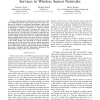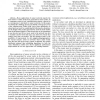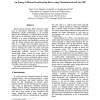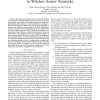VTC
2007
IEEE
14 years 5 months ago
2007
IEEE
— Heterogeneous wireless sensor networks are made up of different kinds of nodes. Some nodes, the sensors, are used as an interface to the physical environment. Other nodes act i...
SECON
2007
IEEE
14 years 5 months ago
2007
IEEE
—Wireless Sensor Networks (WSNs) require robustness against channel induced errors while retransmission based schemes prove too costly for energy constrained sensor nodes. Channe...
SAINT
2007
IEEE
14 years 5 months ago
2007
IEEE
To achieve a smart sensor network with Web-based sensor nodes such as Field Servers, we propose a hierarchical agent system that manages sensor nodes autonomously and flexibly, an...
RTSS
2007
IEEE
14 years 5 months ago
2007
IEEE
— Many applications of sensor networks require the base station to collect all the data generated by sensor nodes. As a consequence many-to-one communication pattern, referred to...
RTSS
2007
IEEE
14 years 5 months ago
2007
IEEE
Sea depth monitoring is a critical task to ensure the safe operation of harbors. Traditional schemes largely rely on labor-intensive work and expensive hardware. This study explor...
MUE
2007
IEEE
14 years 5 months ago
2007
IEEE
Wireless Sensor Networks (WSNs) have been widely used in environment monitoring to collect useful information. Packet broadcasting is an essential function for establishing a comm...
LCN
2007
IEEE
14 years 5 months ago
2007
IEEE
—Heterogeneous Wireless Sensor Networks (WSNs) are envisioned to provide different types of services in an open and dynamic environment. This paper presents the design, implement...
ISORC
2007
IEEE
14 years 5 months ago
2007
IEEE
Due to the special characteristics (limited battery power, limited computing capability, low bandwidth, need to collect sensor data from multiple fixed-location source nodes to a...
IPPS
2007
IEEE
14 years 5 months ago
2007
IEEE
Our goal is to save energy in wireless sensor networks (WSNs) by periodic duty-cycling of sensor nodes. We schedule sensor nodes between active (transmit or receive) and sleep mod...
IPCCC
2007
IEEE
14 years 5 months ago
2007
IEEE
Key management is the cornerstone for secure communication in sensor networks. Researchers have recently developed many techniques to setup pairwise keys between sensor nodes. How...




